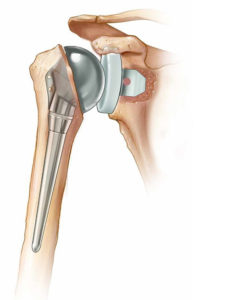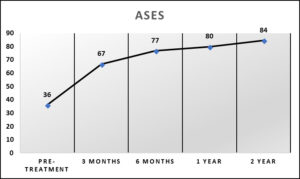Total Shoulder Replacement Outcomes
Proven results from total shoulder arthroplasty procedures performed by Dr. Gobezie, with measurable improvements in pain relief and shoulder function
A total shoulder replacement includes resurfacing of the humeral head with a partial sphere composed of metal and the glenoid with an oblong plastic component. A partial or hemi-shoulder replacement means that only the humeral head is resurfaced.
Total shoulder arthroplasty is one of the most successful orthopedic procedures for relieving pain and restoring function in patients with severe shoulder arthritis. The surgery replaces damaged bone and cartilage with prosthetic components designed to replicate the natural anatomy of the shoulder joint.

Understanding Total Shoulder Replacement
Total shoulder replacement surgery is recommended for patients with end-stage shoulder arthritis who have not responded to conservative treatments. During the procedure, the damaged humeral head is removed and replaced with a metal ball attached to a stem that fits into the upper arm bone. The glenoid (socket) is resurfaced with a plastic component.
Dr. Gobezie uses advanced surgical techniques and the latest implant designs to optimize outcomes. His high surgical volume—performing more than 350 shoulder replacements annually—translates to refined technique and excellent patient outcomes.
Conditions Treated with Total Shoulder Replacement
- Osteoarthritis of the shoulder
- Rheumatoid arthritis
- Post-traumatic arthritis
- Avascular necrosis
- Failed previous shoulder surgery
For detailed information about the surgical technique and post-operative care, download our Total Shoulder Replacement handbook (PDF).
Evidence-Based Outcome Tracking
Dr. Gobezie is passionate about closely following his patients' outcomes after surgery. Not all surgeons take the time to do this. Before surgery, we ask all our patients to complete a standardized questionnaire about their shoulder. We continue to follow each patient's improvement at certain time points after surgery. Pairing these standardized surveys with follow-up visits gives our practice a concrete way to measure our patients' outcomes.
We use three primary outcome measures to assess patient progress:
- Pain Scale (0-10): Patients rate their pain intensity from 0 (no pain) to 10 (worst imaginable pain)
- SANE Score: Single Assessment Numeric Evaluation—patients rate their shoulder as a percentage of normal (0% to 100%)
- ASES Score: American Shoulder and Elbow Surgeons standardized score measuring pain and functional limitations on a 100-point scale
Published studies have indicated that the more times a surgeon performs a surgery, the better the patient outcomes. Additionally, high volume surgeons are able to provide value-based care, that is better outcomes over cost. Dr. Gobezie is not only a top performing surgeon in Ohio but also one of the most experienced and efficient in the country. Each year, he performs more than 350 shoulder replacements and more than 400 arthroscopic shoulder procedures.
Our Total Shoulder Replacement Results
The data we have studied from patients we have treated at the Cleveland Shoulder Institute shows above-average patient-reported outcomes in regards to pain and function. Their pain averages 6 prior to surgery and decreases to an average of 1 out of 10 after surgery. Prior to surgery, patients rate their shoulder on average at 31% of normal. After surgery, they rate their shoulder at about 75% of normal. Similarly, the ASES pain and function score improve from 36 to 84.
(out of 10)
(% of Normal)
(out of 100)
Pain Level Over Time

Pain scores indicate the patients' level of pain from pre-surgery through two years after surgery. All graphs show marked improvement in pain and function in the first 3 months after surgery. These outcomes continue to improve through one and two-year post-surgery milestones.
SANE Score (Shoulder Function)

The SANE score represents how patients rate their shoulder as a percentage of normal, from 0% to 100% with 100% being completely normal function. Our total shoulder replacement patients improve from an average of 31% to 75% of normal function.
ASES Score (Pain & Function)

The ASES score is a standard shoulder assessment that measures pain and functional limitations of daily activities on a 100-point scale. A maximum ASES score of 100 indicates minimal shoulder pain and maximal shoulder function. Our total shoulder replacement patients improve from an average of 36 to 84.
What These Results Mean for You
The outcome data from our practice demonstrates above-average patient-reported results in both pain relief and functional improvement. Patients who undergo total shoulder replacement at the Cleveland Shoulder Institute can expect:
- Significant pain reduction within the first three months
- Continued improvement through one and two years post-surgery
- Return to daily activities with restored function
- High patient satisfaction rates
Dr. Gobezie's high surgical volume translates to refined technique, fewer complications, and better value-based care—meaning better outcomes at competitive cost. His experience with shoulder replacement spans thousands of cases, giving patients confidence in their surgical decision.
Considering Shoulder Replacement?
If you're dealing with severe shoulder arthritis that hasn't responded to conservative treatment, schedule a consultation with Dr. Gobezie to discuss whether total shoulder replacement is right for you.
Schedule Consultation